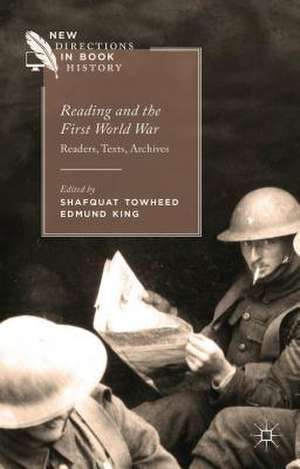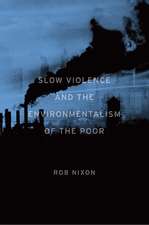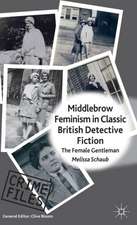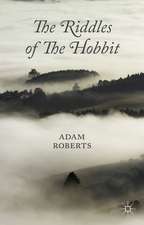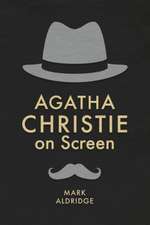Reading and the First World War: Readers, Texts, Archives: New Directions in Book History
Autor Shafquat Towheed, Edmund Kingen Limba Engleză Hardback – 17 aug 2015
Din seria New Directions in Book History
- 17%
 Preț: 393.55 lei
Preț: 393.55 lei - 20%
 Preț: 689.07 lei
Preț: 689.07 lei - 18%
 Preț: 950.21 lei
Preț: 950.21 lei - 20%
 Preț: 691.39 lei
Preț: 691.39 lei - 15%
 Preț: 697.47 lei
Preț: 697.47 lei - 15%
 Preț: 525.35 lei
Preț: 525.35 lei - 15%
 Preț: 525.54 lei
Preț: 525.54 lei -
 Preț: 384.86 lei
Preț: 384.86 lei - 18%
 Preț: 786.18 lei
Preț: 786.18 lei - 15%
 Preț: 581.79 lei
Preț: 581.79 lei - 18%
 Preț: 891.17 lei
Preț: 891.17 lei -
 Preț: 431.94 lei
Preț: 431.94 lei - 15%
 Preț: 587.53 lei
Preț: 587.53 lei - 18%
 Preț: 729.23 lei
Preț: 729.23 lei - 15%
 Preț: 524.22 lei
Preț: 524.22 lei - 18%
 Preț: 737.89 lei
Preț: 737.89 lei -
 Preț: 381.98 lei
Preț: 381.98 lei - 18%
 Preț: 724.50 lei
Preț: 724.50 lei - 15%
 Preț: 640.55 lei
Preț: 640.55 lei - 18%
 Preț: 779.57 lei
Preț: 779.57 lei - 15%
 Preț: 582.30 lei
Preț: 582.30 lei -
 Preț: 452.25 lei
Preț: 452.25 lei - 15%
 Preț: 587.20 lei
Preț: 587.20 lei - 18%
 Preț: 785.11 lei
Preț: 785.11 lei - 20%
 Preț: 525.35 lei
Preț: 525.35 lei - 15%
 Preț: 637.78 lei
Preț: 637.78 lei - 18%
 Preț: 785.55 lei
Preț: 785.55 lei - 18%
 Preț: 789.52 lei
Preț: 789.52 lei - 18%
 Preț: 947.50 lei
Preț: 947.50 lei - 18%
 Preț: 779.08 lei
Preț: 779.08 lei -
 Preț: 221.43 lei
Preț: 221.43 lei - 15%
 Preț: 643.16 lei
Preț: 643.16 lei -
 Preț: 419.81 lei
Preț: 419.81 lei - 15%
 Preț: 697.32 lei
Preț: 697.32 lei -
 Preț: 384.86 lei
Preț: 384.86 lei
Preț: 642.36 lei
Preț vechi: 755.72 lei
-15% Nou
Puncte Express: 964
Preț estimativ în valută:
122.92€ • 128.66$ • 102.30£
122.92€ • 128.66$ • 102.30£
Carte tipărită la comandă
Livrare economică 31 martie-14 aprilie
Preluare comenzi: 021 569.72.76
Specificații
ISBN-13: 9781137302700
ISBN-10: 1137302704
Pagini: 266
Ilustrații: XI, 266 p.
Dimensiuni: 140 x 216 x 18 mm
Greutate: 0.47 kg
Ediția:1st ed. 2015
Editura: Palgrave Macmillan UK
Colecția Palgrave Macmillan
Seria New Directions in Book History
Locul publicării:London, United Kingdom
ISBN-10: 1137302704
Pagini: 266
Ilustrații: XI, 266 p.
Dimensiuni: 140 x 216 x 18 mm
Greutate: 0.47 kg
Ediția:1st ed. 2015
Editura: Palgrave Macmillan UK
Colecția Palgrave Macmillan
Seria New Directions in Book History
Locul publicării:London, United Kingdom
Recenzii
“This collection of 13 essays focuses on readership, representing the democratizing shift in literary research that is now a standard approach to the teaching of literary culture. … This book should be used by researchers working on the study of this war, as well as those working on book and publishing history, since the essays discuss little-known archival possibilities that established researchers may not know, and newcomers should certainly be made aware of.” (Kate Macdonald, First World War Studies, July, 2017)
“As Reading and the First World War demonstrates, a vast number of those involved in World War I–not only soldiers but also civilians–read avidly. … comprises a range of essays addressing topics as varied as the reading practices of war artists behind the line; of conscientious objectors; and of Australian prisoners of war. … the nurses and ambulance drivers who must have read, if only occasionally–ultimately Reading and the First World War contains somethingfor everyone.” (Kabi Hartman, English Literature in Transition, Vol. 60 (1), 2017)
“The history of reading in the First World War is an area of particular significance in this commemorative period. It has benefited from a conjunction of archival and digital projects that makes new accounts and resources available to scholars across the world. … This complex intermingling of experience and imagination animates the collection as a whole, making this not just a gathering of scholarly perspectives, but a testament to the interdependence of all acts of wartime reading, politically and culturally.” (Lucy Collins, SHARP News, sharpweb.org, August, 2016)
“Reading and the First World War participates in the recent digital turn and transnational turn in book history, which are also central to modernist studies. … Reading and the First World War includes some particularly strong essays based on work in neglected archives and collections. It will be of interest not only to book historians (its explicit audience), but also to scholars of modernism.” (Lise Jaillant, Modernism, modernity, Vol. 23 (2), April, 2016)
“As Reading and the First World War demonstrates, a vast number of those involved in World War I–not only soldiers but also civilians–read avidly. … comprises a range of essays addressing topics as varied as the reading practices of war artists behind the line; of conscientious objectors; and of Australian prisoners of war. … the nurses and ambulance drivers who must have read, if only occasionally–ultimately Reading and the First World War contains somethingfor everyone.” (Kabi Hartman, English Literature in Transition, Vol. 60 (1), 2017)
“The history of reading in the First World War is an area of particular significance in this commemorative period. It has benefited from a conjunction of archival and digital projects that makes new accounts and resources available to scholars across the world. … This complex intermingling of experience and imagination animates the collection as a whole, making this not just a gathering of scholarly perspectives, but a testament to the interdependence of all acts of wartime reading, politically and culturally.” (Lucy Collins, SHARP News, sharpweb.org, August, 2016)
“Reading and the First World War participates in the recent digital turn and transnational turn in book history, which are also central to modernist studies. … Reading and the First World War includes some particularly strong essays based on work in neglected archives and collections. It will be of interest not only to book historians (its explicit audience), but also to scholars of modernism.” (Lise Jaillant, Modernism, modernity, Vol. 23 (2), April, 2016)
Notă biografică
Jonathan Arnold, independent scholar, UK Jonathan Black, Kingston University, UK. Jim Cleary, Griffith University, Australia Emmanuel Debruyne, Université catholique de Louvain, France. Catherine Feely, University of Derby, UK. Edmund G.C. King, Open University, UK. Alisa Miller, Norwich University of the Arts, UK. Sara Mori, independent scholar, Italy Robert L. Nelson, University of Windsor, Canada Jane Potter, Oxford Brookes University, UK. Jonathan Rose, Drew University, USA. Max Saunders, King's College London, UK. Shafquat Towheed, Open University, UK.
